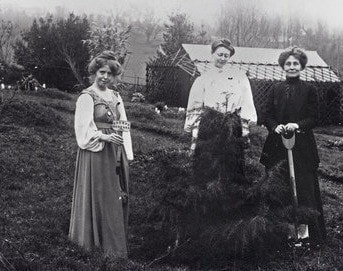|
Helen Cave nee Cooke, full name Helen Cassandra, was arrested in November 1911. Born in 1863, in Great Budworth, Cheshire, to Samuel, a vicar, and Nina, the family moved to Northbourne, Kent, in 1870, when Helen’s father was appointed to the local church. Samuel died in 1877, leaving Nina a widow with six children: three sons and three daughters. In February 1892, Helen married Edward Cave, a widowed doctor. They settled in Bath and a daughter; Nina born in 1893. Helen became involved with the Bath Branch of the WSPU. She is first mentioned in Votes for Women, 18 November 1910, donating to the £100,000 fund. Helen donated, to the local branch, sold jars of marmalade and raised further funds by selling sweets. While Edward and Nina are included in the 1911 census return Helen is not; her intention to be excluded clear from a speech she gave at a gathering of the Bath Branch where Jane Brailsford also spoke. Helen undertook to sell Votes for Women every Saturday in Radstock, a town close to Bath. Clearly persuasive, she extracted a promise from a local newsagent to display a suffragette poster. Alongside her role as a vendor, Helen undertook to organise all the advertising for a WSPU jumble sale. During June 1910 , the WSPU organised The Women’s Coronation Procession which brought together many suffrage groups. The estimated attendance was over 40,000. The procession marched, led by Charlotte Despard, from Westminster to the Albert Hall. Helen along with sisters, Grace and Atehel Tollemache and Miss Frederici distributed handbills advertising the march. The following month, Helen hosted an At Home addressed by Dr Mary Morris. Helen was arrested, the following November, for obstruction alongside Atehel. Found guilty, she was fined five shillings or in the alternate five days in prison. Helen elected to go to prison. Mary Blathwayt, a keen supporter of the suffrage campaign, lived at Eagle House in the village of Batheaston, not far from Bath. Mary and her husband made their summerhouse available, known as the Suffragette Retreat, to women released from prison, often after hunger striking, for recuperation. Nearby, trees were planted to mark individual suffragette achievements which became known as Annie’s Arboretum, after Annie Kenney. In all around fifty trees were planted. The last was by Helen. No records have been found of Helen being subjected to force feeding. Mary became appalled at the increasingly militant actions of the suffragettes and encouraged Helen to step back. While she continued to donate to the WSPU funds Helen took no further direct part in the campaign. Helen died in 1925.
When her husband passed away nine years later, he bequeathed £6000 to St Bartholomew’s Hospital to fund an entrance scholarship for students to be known as the Helen Cave Memorial Scholarship.
0 Comments
|
Categories
All
|
Proudly powered by Weebly


 RSS Feed
RSS Feed
